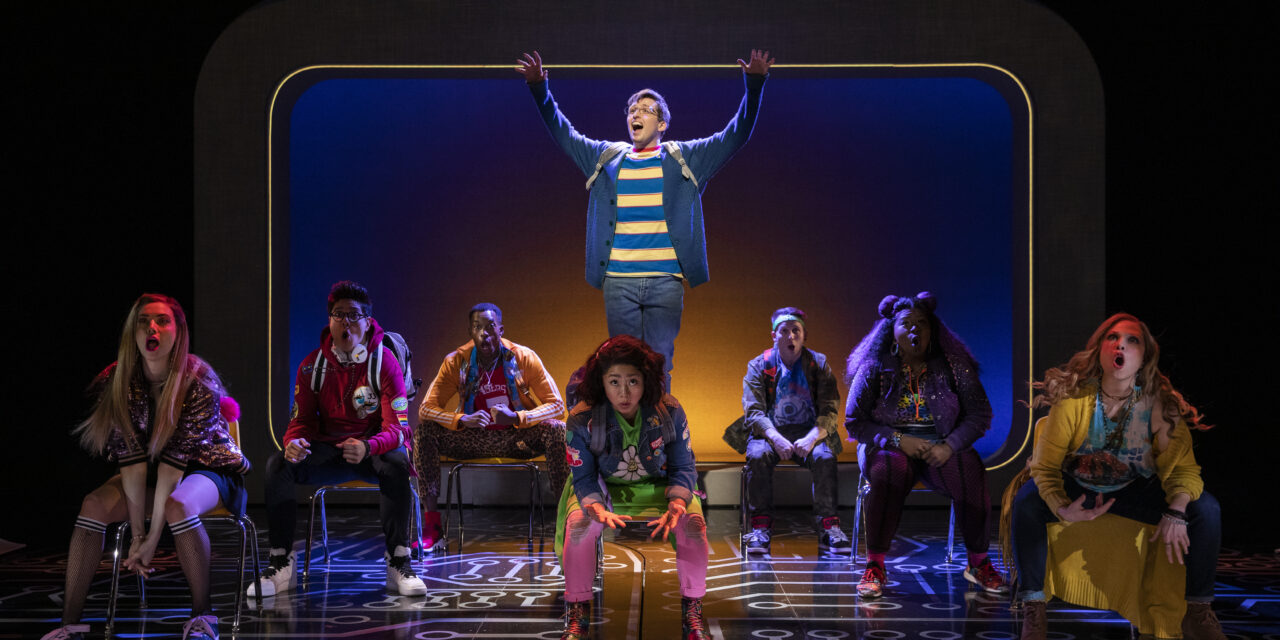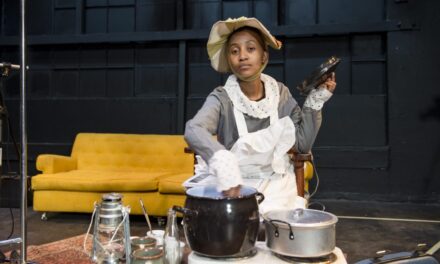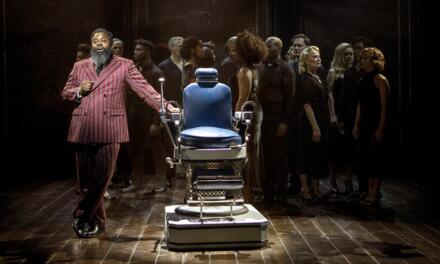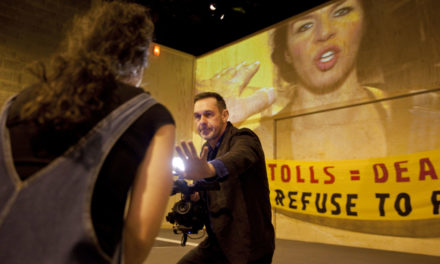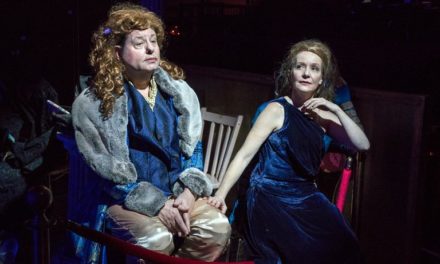The high school musical’s calling card has always been the “be yourself” thematic. A nerdy, unpopular kid, desperate for social capital, makes a radical transformation, realizes his or her mistake and learns to be themselves again. That’s how it works. I never quite understood how Grease so successfully defied this model. Sandy learns to be cool by smoking cigarettes and wearing leather pants. Then the musical ends.
But never has a play gone the way of this well-trodden path via brain-implanted computer domination, as is the case with Be More Chill, Joe Iconis and Joe Tracz viral sensation turned Broadway musical, now open at the Lyceum Theatre.
Both in life and art, the lines between digital and real existence blur in Be More Chill. Jeremy (Will Roland), hopelessly insecure and anxious, learns from his school bully—once a nerd, too—about an ingestible supercomputer that’ll take control of his brain and make him cool. Take the pill, called a “squip,” manifested by an anime-inspired, Keanu Reeves-esque mentor in his mind (Jason Tam), obey its instructions and the paralyzing social anxiety that comes with being a high school teenager melts into swagger. “Gotta get an upgrade—don’t worry about the guilt you feel. Take a breath and seal the deal,” the lyrics go.
It works, and as Jeremy’s squip takes him to the top of suburban New Jersey high school hierarchy, hairstyle and friends swapped out, the computer’s destructive and evolving potential threatens to take over the entire school, one malleable mind at a time—a sci-fi parable of digital life and teenage insecurity.
But, like its protagonist, Be More Chill is itself a strange product of human creation and digital life, coming to Broadway with an already viral following. The musical first opened at the Two River Theater in New Jersey in 2015. It ran for four weeks, but its cast album, through whatever YouTube and Tumblr algorithmic alchemy, became a viral phenomenon, amassing an army of fans across the globe that’s ushered this techno story of teenage angst first to a sold-out run off-Broadway last summer and now to the Lyceum Theatre.
On Broadway, Be More Chill looks a lot like its new-musical peers—sleek and shiny, sardonically teen-focused, duty-bound by the aesthetic eclecticism of today’s youth and built by a score that sounds nearly like a 2008 Vampire Weekend mixtape turned itself into a musical. Yet, I hesitate to put Be More Chill squarely within the mold that Dear Evan Hansen popularized, Mean Girls commercialized and The Prom piggy-backed. Iconis and Tracz’ creation, adapted from Ned Vizzini’s book of the same name, succeeds in injecting some irreverence into its medium, a particular weirdness to its characters—not vacant eccentricity, but definition—that feels somehow new to its genre.
Jeremy is unpopular and dorky, but his unpopularity isn’t ethereal. Whatever awkwardness he embodies stems obviously from a well of insecurity and social anxiety, not from some unfortunate affinity for attracting wedgies. His best friend Michael (George Salazar) is equally as insecure, but not downtrodden; he’s a queer stoner, passionate about 90s nostalgia, whose status as an outcast seems to come from neither of those attributes. Jeremy’s love interest, Christine (Stephanie Hsu), a theatre-loving weirdo who reads Barbra Streisand biographies at play practice and dreams of making performance art at bowling alleys, earns enough respect for her unapologetic oddity.
All of Be More Chill’s characters carry, whether popular or unpopular, a particular ownership over what makes them weird. Not a sense of clique identity, per se — as musicals like Mean Girls continue to insist is universally relatable—but an acceptance toward their own self-creation, unique in a younger generation compelled to find singularity in each of its members. For today’s teens, self-invention is not vacuous, but a necessary part of life—and Be More Chill, perhaps ahead of the tide, instills this reality in its exaggerated characters. That they’re weird doesn’t seem to be the problem; insecurity is where the trouble lies. Maybe that’s why the musical is so relatable.
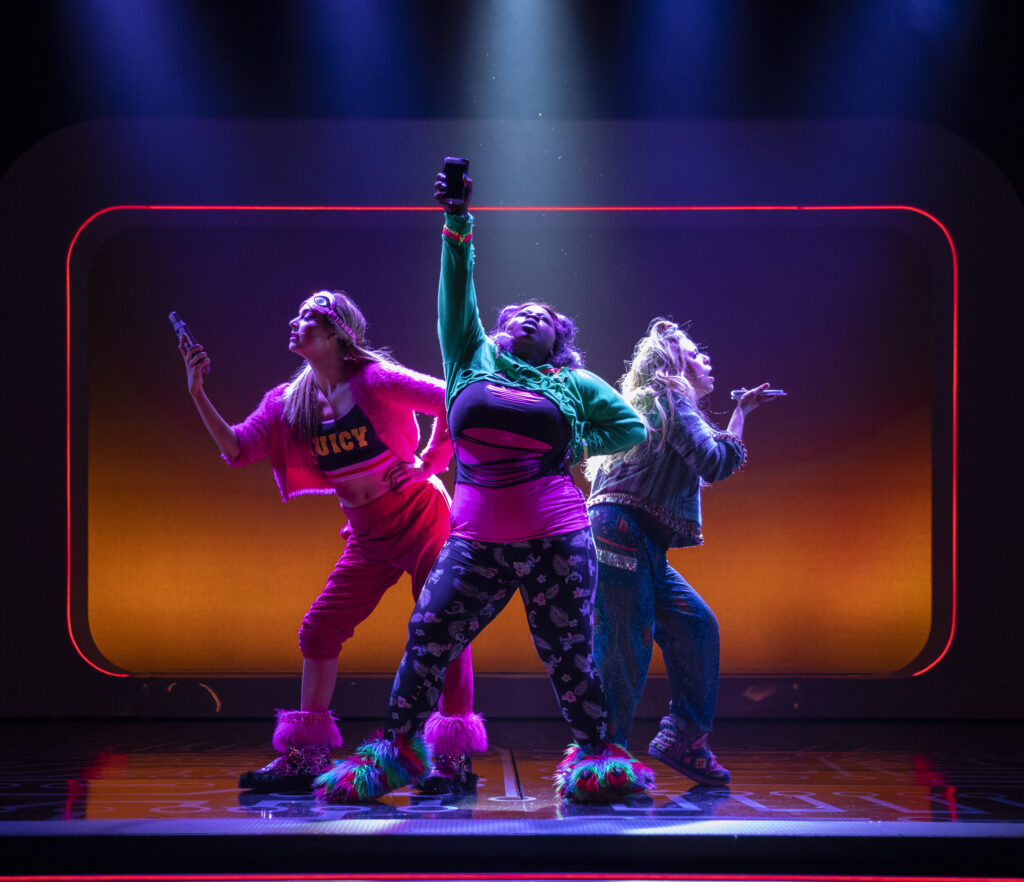
Katlyn Carlson, Tiffany Mann and Lauren Marcus in Be More Chill. Courtesy of Maria Baranova.
Be More Chill also succeeds in shrugging off the shiny sterility that defines the sleek, contemporary teen musical. Dark and twisty, campy and dedicated to the funkier, raunchier side of internet-bound teenage life—Jeremy’s first line is “I’m waiting for my porno to load”—Be More Chill bears a refreshing edge, an attractive funk within its electro borders that outperforms the sanitized sensibility of its category. It’s got something cool, not just young.
Stylistically, it seems Be More Chill’s creators are reaching for a sort of aesthetic update to the retro sci-fi, Area 51 look, submerged within a set design that looks, with the help of Alex Basco Koch’s seizure-inducing projection design, predictably like the dark interiors of a supercomputer. Think of a less-colorful, muted Little Shop Of Horrors, suspended in VR. Or an extraterrestrial diner waitress with a member of Generation Z at home.
Something is always twisted in just the right way. Joe Iconis’ score, as Broadway pop and straight-toned as ever, features the theremin, the sound of alien arrival everywhere, inflecting a refreshing camp into a score that otherwise blends into the crowd. Bobby Frederick Tilley’s contemporary costuming, colorful and assorted, captures the mix of H&M throw away fashion, Forever 21 style and Salvation Army vintage that compiles most teens’ closets—yet his interpretation, farcical and exaggerated, elevates this costuming trend from mimicry to mockery.
Like its characters, Be More Chill’s cast is an exceptional part of this production, retaining every member from its off-Broadway run last summer.
Will Roland, who has played Jeremy since Two River Theater, achieves the perfect characterization of Be More Chill’s protagonist. Neither Jeremy the anxious dork nor Jeremy the popular kid are too extreme to be believable, portraying both with a sort of level-headedness and calm, an obvious introspection, that grounds Be More Chill in a convincing and conceivable persona. His voice, clear and unstrained, but not as indulgent as I may have wanted, is a good match for Iconis’ score, which shares similar characteristics.
Where Roland is judicious, Stephanie Hsu, who plays the ostentatious Christine Canigula, is extravagant. Completely unbound and admirably unpredictable, Hsu, like her character, brings an entertaining quirk to Broadway unlike anyone else on stage.
As Michael, George Salazar is the real vocal talent of Be More Chill’s principal cast (superseded only by Tiffany Mann, who as fringe character Jenna Rolan, blows the roof off the Lyceum Theatre every time she opens her mouth in the ensemble; I searched frantically for her name in the program during the show, dropping everything from my lap and making a scene). Michael In The Bathroom is an anthem for crippling teenage anxiety and the most well-sung number in a score chock-full of repetitive, uninteresting melodies. Salazar’s Michael isn’t simply the sidekick who gets left in the dust with Jeremy’ glow-up. In Michael’s eccentricity, crushed into insecurity once abandoned by Michael, then blossomed into empowerment once Jeremy needs saving, lies the true thematic heart of this teenage parable.
Beyond that heart, I’m not so sure how far the “cool” aesthetic Be More Chill embodies will go, exactly how deep that well runs. The musical does embody an audible and aesthetic trend that’s become the norm for increasingly youth-centered Broadway creations, inevitably asking the question of what is the work and responsibility of new Broadway musicals in 2019.
Its origin story, that of a scrappy musical turned viral sensation, then turned Broadway production, offers a tale of equal parts caution and confidence, whichever you’re more inclined to believe.
Call me a traditionalist, but Broadway theater has a responsibility to do more than entertain. I want to sit forward in my seat. If you start with a story frame and setting that’s as tried and re-tried as Be More Chill’s, add an unusual twist and just enough strobe lights, you’ll get something that’s damn entertaining. Ordinarily, I’d think that wasn’t enough.
Yet, Be More Chill’s viral potency, judging from the hoards of teenagers that swarm the lobby and stage door of the Lyceum Theatre nightly, has the potential to keep young audiences excited and interested in Broadway—and, fooled as I may be by the inherent optimism of a teenage musical, I’m not above celebrating that achievement, either.
This post was written by the author in their personal capacity.The opinions expressed in this article are the author’s own and do not reflect the view of The Theatre Times, their staff or collaborators.
This post was written by Michael Appler.
The views expressed here belong to the author and do not necessarily reflect our views and opinions.

